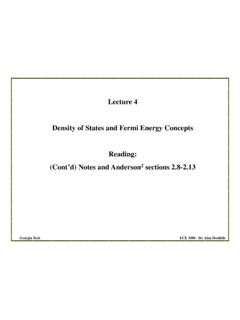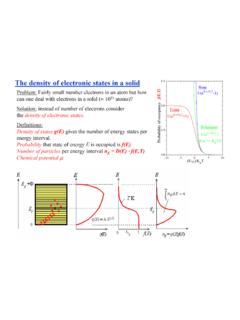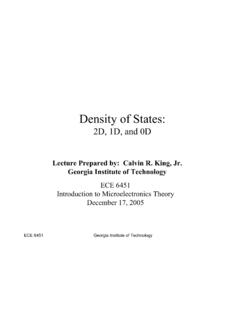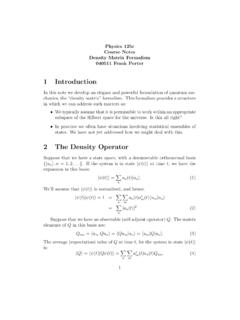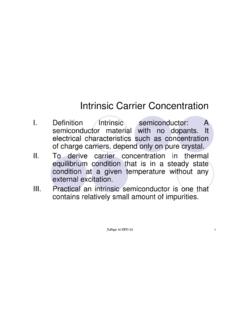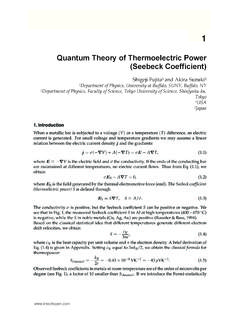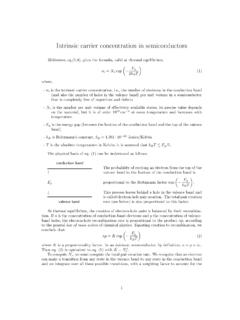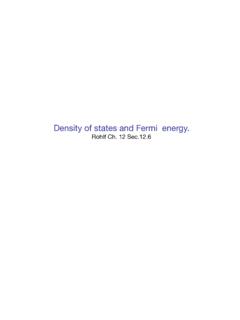Transcription of 1. Boltzmann distribution - Huang Lab
1 Examples of macrostates and microstates Outline of chapter 1. Boltzmann distribution a. Macrostate vs microstate b. derivation of Boltzmann distribution c. Definition of Partition function Q d. example of barometric pressure e. example of particle velocity distribution 2. Partition function a. Utility of the partition function b. density of states c. Q for independent and dependent particles d. The power of Q: deriving thermodynamic quantities from first principles 3. Examples a. Schottky two-state model b. Curie s law of paramagnetism c. quantum mechanical particle in a box d. rotational partition function ======================================== ======================================== =============== 1.
2 Boltzmann distribution a. Macrostate, microstate Key points: Probability (#ways could happen) / (all possible ways) o Probability to pull an Ace o Guess what number I m thinking 1 to 10? Microstate: particular instance (what you would see if you took a picture of the system) Macrostate: collection of microstates with same state variables (E, N, V, etc.) p1, are the probabilities of the microstates. o If energies were equal, 1/5 o When energies not equal? Boltzmann . Intuition on what we are trying to do: Describe the probabilities that different states of different energy level are occupied. What happens when T is low? What happens when T is high? What is the entropy of the system?
3 Entropy originates in probability theory Measure of flatness of a distribution Low entropy distribution is sharp, system is ordered few accessible states High entropy distribution is broad, system is disordered many accessible states Goal: Find flattest distribution (highest entropy) that is physical Agrees with thermodynamics Probabilities sum to 1 b. derivation of Boltzmann distribution Derive Boltzmann distribution pj ( Ej ) for system of: T = 1 T = 10 T = 100 N particles in a box Energy levels Ej constant T, V, and N (Helmholtz) Begin with Helmholtz free energy, Must find minimum subject to constraint, . Replace U and S with functions of pj and Ej Can then solve for pj in terms of Ej to find distribution relating energy to probability ( Boltzmann ) For U, For S, Inserting into F ( ) Now just minimize F subject to constraint using Lagrange multipliers, [( ) ( )] Differentiating, [( ) ( )] For dF = 0 each j term must equal zero since they are all positive.
4 ( ) Solving for pj in terms of Ej yields, To remove from the equation, plug into and divide pj by 1, ie, Providing the normalized probability distribution . Conceptually, what we have done is to find flattest distribution that satisfies There is only one possible distribution , the Boltzmann distribution . c. Definition of Partition function Q Q is defined as the partition function What does the partition function mean, conceptually? Loosely speaking, it is the number of accessible states . For low T only ground state accessible.
5 For high T all states accessible. This is why it is necessary to normalize by Q in order to calculate a probability: Numerator is number of states available at particular Ej Denominator Q is number of total states accessible for that temperature. Probability of seeing that energy is thus number of those states divided by all accessible states . d. Example of barometric pressure Use the Boltzmann distribution to write the pressure vs height in the atmosphere. How do we think of this problem: Imagine a bunch of gremlins on the surface of the earth throwing balls straight up where velocity varies and average is dictated by temperature Final height achieved depends on initial kinetic energy, since kinetic is converted into gravitational potential energy.
6 If you look at density of balls, will be denser at surface and less dense high up. How do we calculate density as a function of height? Number of balls at a particular height depends on number of balls with enough energy to reach that height: => Number of particles at height 0 in volume V => Number of particles at height z in volume V Hence, ratio of balls at height z to height 0 is, Energy of a particle in the atmosphere is the gravitational potential energy Plugging in, To find how the pressure varies, use the idea gas law => , assuming V and T constant This shows that the pressure goes down exponentially with z.
7 E. Example of particle velocity distribution Box full of balls moving with random velocities. Kinetic energy of each particle given by, To compute Boltzmann factor, partition function must sum over all states of the particle. Because particle has three velocities (vx, vy, vz), must sum over each of these when computing Q. Easy way to do this is to start y computing the Boltzmann distribution for just the x-axis velocities. Where the integral is over all possible velocity states (x-velocities) Remember, numerator is roughly number of states available at that energy. Denominator is number of states accessible in total.
8 If , then distribution is flat. Can simplify to obtain, To find the probability distribution for the speed, sim ( ) Armed with the probability distribution for v, we can calculate the moments of the distribution , and . Recall that for a random variable the expected value is, ( ) ( ) Examples of macrostates and microstates 2. Partition function a. Utility of the partition function What does the partition function mean, conceptually?
9 Loosely speaking, it is the number of accessible states . Low T only ground state accessible. High T all states accessible. b. density of states In the sum is over all possible states . Sometimes it s convenient to instead sum over energies, Ej. For this, we must define the density of states , which is the number of states at a particular energy level, W(El) That is, the system may have multiple microstates in a particular macrostate energy level, and W(El) tells us how many such microstates are in each level. This allows us to change the limits of the sum that we sum over energy levels and multiply each term by the number of states in that energy level, For example, in the bead chain problem from last time, Q could be calculated by summing over all states : Or by summing over energy levels using the density of states , = Using the density of states , you can often guess Q without having to sum a bunch of terms.
10 For example, take the 6-bead chain problem: What s the partition function? T = 1 T = 10 T = 100 c. Q for independent and dependent particles The partition function is a crank that allows us to go from simple things like the number of states , energy levels, etc., and calculate less obvious, but potentially more useful, things like the free energy, entropy, and so on. Sometimes turning the crank requires summing over all possible states and, often, this is not possible, such as when you have 1023 states . In some instances, due to symmetries in the problem, it is possible to simplify the partition function for even a very large system so that it can be written down compactly.
